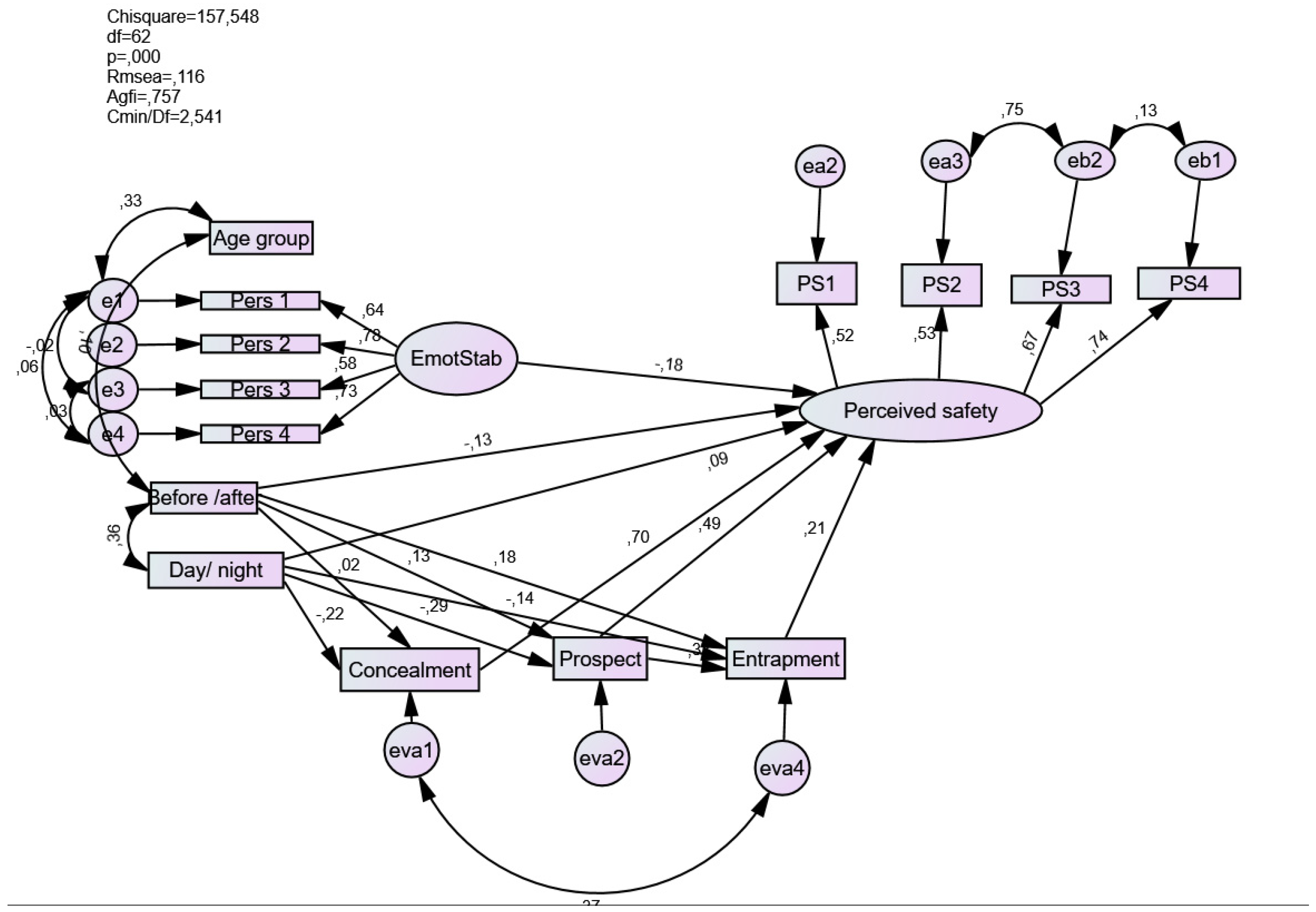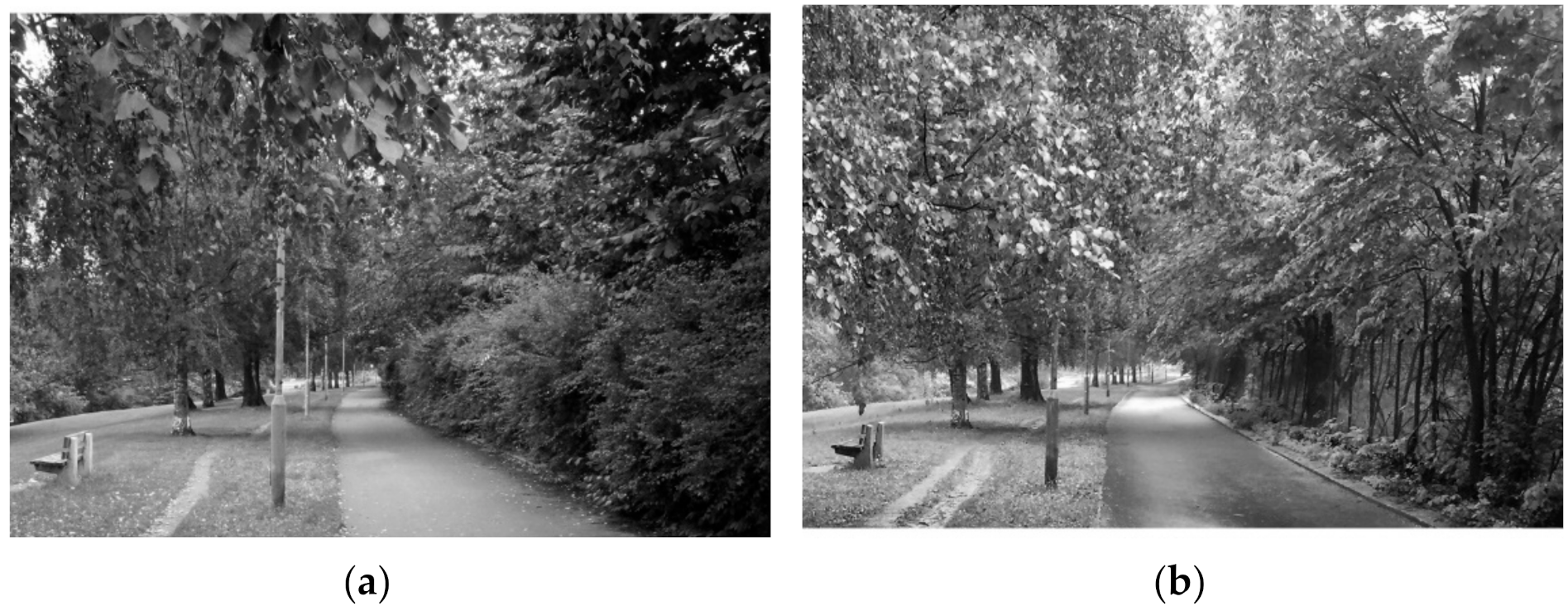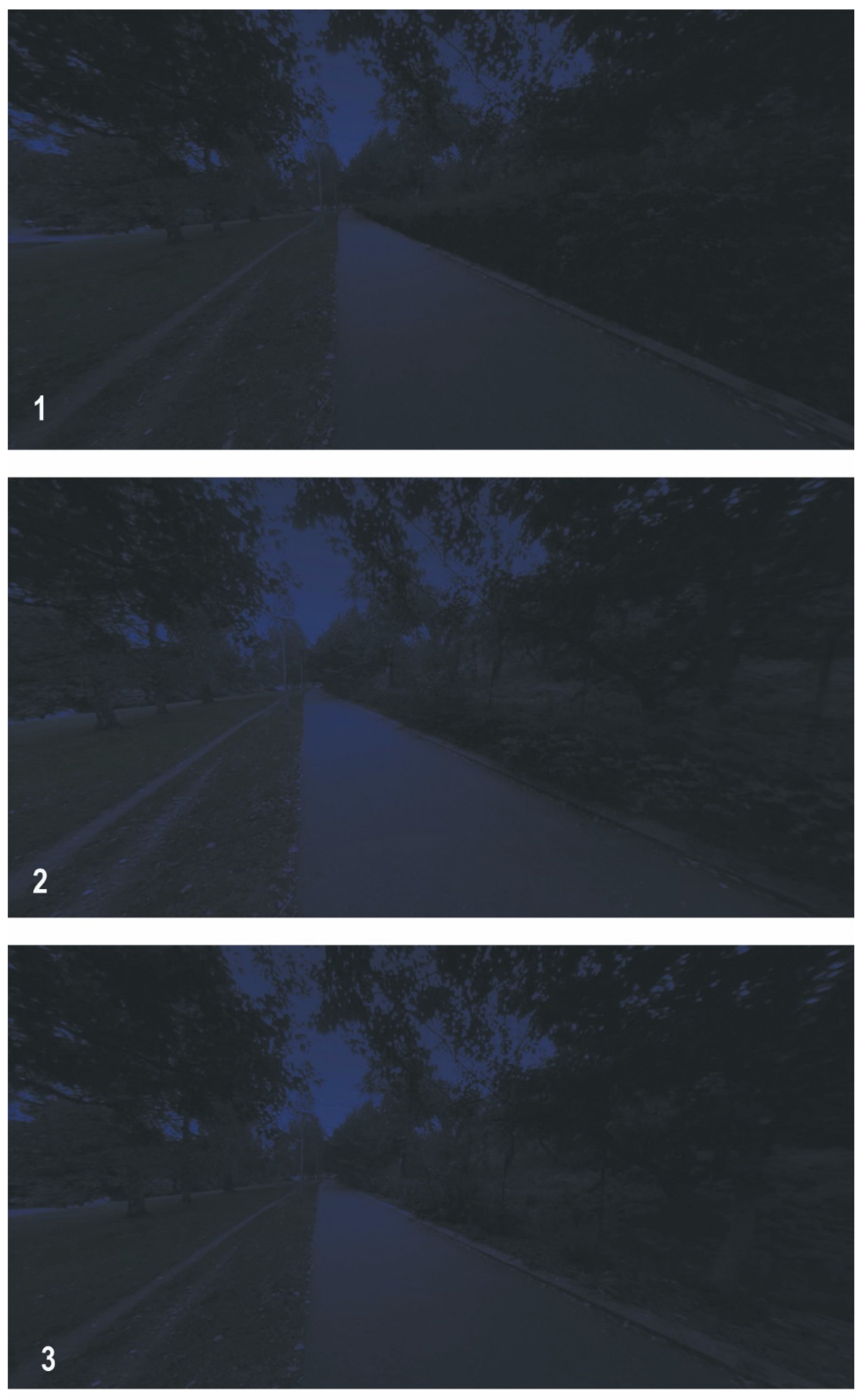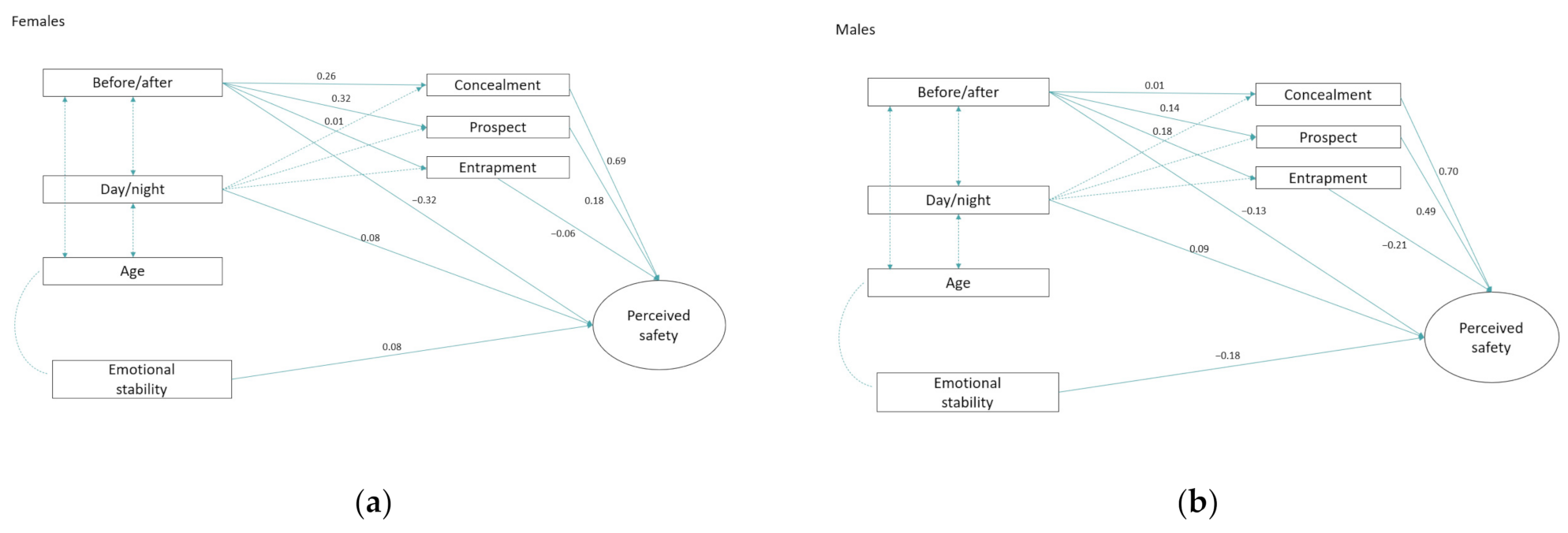Testing the Effect of Hedge Height on Perceived Safety—A Landscape Design Intervention
Abstract
1. Introduction
Objective
2. Materials and Methods
2.1. Study Design
2.2. Study Site and Landscape Design Intervention
2.3. Field Experiment
2.3.1. Participants and Procedure
2.3.2. Questionnaire
2.4. Virtual Reality Experiment
2.4.1. Participants
2.4.2. Stimuli and VR Setup
2.4.3. Procedure
2.4.4. Questionnaire
2.5. Data Analysis
3. Results
3.1. Field Experiment
3.1.1. Descriptive Results
3.1.2. Structural Equation Model
3.2. Virtual Reality Experiment
4. Discussion
Methodological Discussion
5. Conclusions
Author Contributions
Funding
Institutional Review Board Statement
Informed Consent Statement
Data Availability Statement
Acknowledgments
Conflicts of Interest
Appendix A


References
- Lapham, S.C.; Cohen, D.A.; Han, B.; Williamson, S.; Evenson, K.R.; McKenzie, T.L.; Hillier, A.; Ward, P. How important is perception of safety to park use? A four-city survey. Urban Stud. 2015, 53, 2624–2636. [Google Scholar] [CrossRef]
- Weimann, H.; Rylander, L.; van den Bosch, M.A.; Albin, M.; Skärbäck, E.; Grahn, P.; Björk, J. Perception of safety is a prerequisite for the association between neighbourhood green qualities and physical activity: Results from a cross-sectional study in Sweden. Health Place 2017, 45, 124–130. [Google Scholar] [CrossRef] [PubMed]
- WHO Regional Office for Europe. Urban Green Spaces and Health: A Review of Evidence. Available online: http://www.euro.who.int/data/assets/pdf_file/0005/321971/Urban-green-spaces-and-health-review-evidence.pdf (accessed on 28 February 2021).
- Wolfe, M.K.; Mennis, J. Does vegetation encourage or suppress urban crime? Evidence from Philadelphia, PA. Landsc. Urban Plan. 2012, 108, 112–122. [Google Scholar] [CrossRef]
- Troy, A.; Grove, J.M.; O’Neil-Dunne, J. The relationship between tree canopy and crime rates across an urban–rural gradient in the greater Baltimore region. Landsc. Urban Plan. 2012, 106, 262–270. [Google Scholar] [CrossRef]
- Shepley, M.; Sachs, N.; Sadatsafavi, H.; Fournier, C.; Peditto, K. The impact of green space on violent crime in urban environments: An evidence synthesis. Int. J. Environ. Res. Public Health 2019, 16, 5119. [Google Scholar] [CrossRef]
- Mouratidis, K. The impact of urban tree cover on perceived safety. Urban For. Urban Green. 2019, 44, 126434. [Google Scholar] [CrossRef]
- Donovan, G.H.; Prestemon, J.P. The effect of trees on crime in Portland, Oregon. Environ. Behav. 2012, 44, 3–30. [Google Scholar] [CrossRef]
- Foster, S.; Giles-Corti, B.; Knuiman, M. Does fear of crime discourage walkers? A social-ecological exploration of fear as a deterrent to walking. Environ. Behav. 2014, 46, 698–717. [Google Scholar] [CrossRef]
- Maruthaveeran, S.; van den Bosh, C.K. Fear of crime in urban parks—What the residents of Kuala Lumpur have to say? Urban For. Urban Green. 2015, 14, 702–713. [Google Scholar] [CrossRef]
- Jorgensen, L.J.; Ellis, G.D.; Ruddell, E. Fear perceptions in public parks: Interactions of environmental concealment, the presence of people recreating, and gender. Environ. Behav. 2013, 45, 803–820. [Google Scholar] [CrossRef]
- Sang, Å.O.; Sang, N.; Hedblom, M.; Sevelin, G.; Knez, I.; Gunnarsson, B. Are path choices of people moving through urban green spaces explained by gender and age? Implications for planning and management. Urban For. Urban Green. 2020, 49, 126628. [Google Scholar] [CrossRef]
- Richardson, E.A.; Mitchell, R. Gender differences in relationships between urban green space and health in the United Kingdom. Soc. Sci. Med. 2010, 71, 568–575. [Google Scholar] [CrossRef] [PubMed]
- United Nations. Sustainable Development Goal 11. Available online: https://sustainabledevelopment.un.org/sdg11 (accessed on 8 February 2021).
- Iqbal, A.; Ceccato, V. Is CPTED useful to guide the inventory of safety in parks? A case study in Stockholm, Sweden. Int. Crim. Justice Rev. 2015, 26, 150–168. [Google Scholar] [CrossRef]
- Evensen, K.H.; Hemsett, G.; Nordh, H. Developing a place-sensitive tool for park-safety management—Experiences from green-space managers and female park users in Oslo. Urban For. Urban Green. 2021, 60, 127057. [Google Scholar] [CrossRef]
- Sreetheran, M.; van den Bosch, C.C.K. A socio-ecological exploration of fear of crime in urban green spaces—A systematic review. Urban For. Urban Green. 2014, 13, 1–18. [Google Scholar] [CrossRef]
- Root, E.D.; Silbernagel, K.; Litt, J.S. Unpacking healthy landscapes: Empirical assessment of neighborhood aesthetic ratings in an urban setting. Landsc. Urban Plan. 2017, 168, 38–47. [Google Scholar] [CrossRef]
- Williams, T.G.; Logan, T.M.; Zuo, C.T.; Liberman, K.D.; Guikema, S.D. Parks and safety: A comparative study of green space access and inequity in five US cities. Landsc. Urban Plan. 2020, 201, 103841. [Google Scholar] [CrossRef]
- Appleton, J. The Experience of Landscape; Wiley: Chichester, UK, 1996. [Google Scholar]
- Gatersleben, B.; Andrews, M. When walking in nature is not restorative: The role of prospect and refuge. Health Place 2013, 20, 91–101. [Google Scholar] [CrossRef]
- Jiang, B.; Chang, C.Y.; Sullivan, W.C. A dose of nature: Tree cover, stress reduction, and gender differences. Landsc. Urban Plan. 2014, 132, 26–36. [Google Scholar] [CrossRef]
- Nasar, J.L.; Jones, K.M. Landscapes of fear and stress. Environ. Behav. 1997, 29, 291–323. [Google Scholar] [CrossRef]
- Lis, A.; Iwankowski, P. Why is dense vegetation in city parks unpopular? The mediative role of sense of privacy and safety. Urban For. Urban Green. 2021, 59, 126988. [Google Scholar] [CrossRef]
- Jiang, B.; Mak, C.N.S.; Larsen, L.; Zhong, H. Minimizing the gender difference in perceived safety: Comparing the effects of urban back alley interventions. J. Environ. Psychol. 2017, 51, 117–131. [Google Scholar] [CrossRef]
- Blöbaum, A.; Hunecke, M. Perceived danger in urban public space: The impacts of physical features and personal factors. Environ. Behav. 2005, 37, 465–486. [Google Scholar] [CrossRef]
- Jansson, M.; Fors, H.; Lindgren, T.; Wistrom, B. Perceived personal safety in relation to urban woodland vegetation—A review. Urban For. Urban Green. 2013, 12, 127–133. [Google Scholar] [CrossRef]
- Lis, A.; Pardela, Ł.; Can, W.; Katlapa, A.; Rąbalski, Ł. Perceived danger and landscape preferences of walking paths with trees and shrubs by women. Sustainability 2019, 11, 4565. [Google Scholar] [CrossRef]
- Campagnaro, T.; Vecchiato, D.; Arnberger, A.; Celegato, R.; Da Re, R.; Rizzetto, R.; Semenzato, P.; Sitzia, T.; Tempesta, T.; Cattaneo, D. General, stress relief and perceived safety preferences for green spaces in the historic city of Padua (Italy). Urban For. Urban Green. 2020, 52, 126695. [Google Scholar] [CrossRef]
- Heydarian, A.; Carneiro, J.P.; Gerber, D.; Becerik-Gerber, B.; Hayes, T.; Wood, W. Immersive virtual environments versus physical built environments: A benchmarking study for building design and user-built environment explorations. Autom. Constr. 2015, 54, 116–126. [Google Scholar] [CrossRef]
- Smith, J.W. Immersive virtual environment technology to supplement environmental perception, preference and behavior research: A review with applications. Int. J. Environ. Res. Public Health 2015, 12, 11486–11505. [Google Scholar] [CrossRef]
- Baran, P.K.; Tabrizian, P.; Zhai, Y.; Smith, J.W.; Floyd, M.F. An exploratory study of perceived safety in a neighborhood park using immersive virtual environments. Urban. For. Urban. Green 2018, 35, 72–81. [Google Scholar] [CrossRef]
- Wikipedia. Parker i Oslo. Available online: https://no.wikipedia.org/wiki/Parker_i_Oslo (accessed on 28 February 2021).
- Herzog, T.R.; Kutzli, G.E. Preference and perceived danger in field/forest settings. Environ. Behav. 2002, 34, 819–835. [Google Scholar] [CrossRef]
- Johansson, M.; Rosén, M.; Küller, R. Individual factors influencing the assessment of the outdoor lighting of an urban footpath. Lighting Res. Technol. 2011, 43, 31–43. [Google Scholar] [CrossRef]
- Donnellan, M.B.; Oswald, F.L.; Baird, B.M.; Lucas, R.E. The mini-IPIP scales: Tiny-yet-effective measures of the big five factors of personality. Psychol. Assess. 2006, 18, 192–203. [Google Scholar] [CrossRef] [PubMed]
- Jöreskog, K.G. A general approach to confirmatory maximum likelihood factor analysis. Psychometrika 1969, 34, 183–202. [Google Scholar] [CrossRef]
- Hu, L.T.; Bentler, P.M.; Hoyle, R.H. Evaluating model fit. In Structural Equation Modeling. Concepts, Issues, and Applications; Hoyle, R.H., Ed.; Sage Publications: London, UK, 1995. [Google Scholar]



| Methods | n | Hedge Height | Time of Day |
|---|---|---|---|
| Field experiment | 254 | Low, tall | Day |
| VR experiment | 19 | Low, medium, tall | Evening |
| Demographic | Before Intervention (%) | After Intervention (%) |
|---|---|---|
| Gender | ||
| Female | 65 | 47 |
| Male | 35 | 53 |
| Age | ||
| <30 years | 43 | 18 |
| 30–59 years | 46 | 68 |
| >60 years | 11 | 15 |
| Education | ||
| Secondary school | 20 | 6 |
| University/college < 4 years | 35 | 36 |
| University/college ≥4 years | 46 | 58 |
| Familiarity with park | ||
| Less than daily visits | 52 | 34 |
| Daily visits | 48 | 66 |
| Previous negative park experience | ||
| Never | 69 | 86 |
| Once | 20 | 6 |
| Outcome Variable | Items |
|---|---|
| Perceived environmental attributes Prospect | From this place I have a good overview; Is it easy to see far without getting the view blocked? |
| Concealment | Are you worried about what can be around you here?; Are you worried about what can be behind you here?) |
| Entrapment | Can you easily get away from this place?; Is it easy to move here? |
| Perceived safety | I feel safe here; I feel anxious here (reversed); I can walk here by myself; I would walk a long way to avoid this place (reversed) |
| 1 Outcome Variable | Score | |
|---|---|---|
| Before Intervention | After Intervention | |
| Prospect | 4.3 | 4.7 |
| Concealment | 4.6 | 4.8 |
| Entrapment | 2.9 | 2.7 |
| Perceived safety | 5.4 | 5.5 |
| Emotional stability 2 | 2.7 | 2.2 |
| Outcome Variable | Standardised Total Effect | |
|---|---|---|
| Females | Males | |
| Prospect | 0.32 | 0.14 |
| Concealment | 0.26 | 0.02 |
| Entrapment | −0.15 | −0.22 |
| Perceived safety | 0.32 | −0.01 |
| Perceived Safety | Females M (SD) | Males M (SD) |
|---|---|---|
| Low hedge | 2.5 (1.0) | 4.1 (0.5) |
| Medium hedge | 2.8 (0.7) | 3.8 (0.7) |
| Tall hedge | 2.5 (0.9) | 3.7 (0.9) |
Publisher’s Note: MDPI stays neutral with regard to jurisdictional claims in published maps and institutional affiliations. |
© 2021 by the authors. Licensee MDPI, Basel, Switzerland. This article is an open access article distributed under the terms and conditions of the Creative Commons Attribution (CC BY) license (https://creativecommons.org/licenses/by/4.0/).
Share and Cite
Evensen, K.H.; Nordh, H.; Hassan, R.; Fyhri, A. Testing the Effect of Hedge Height on Perceived Safety—A Landscape Design Intervention. Sustainability 2021, 13, 5063. https://doi.org/10.3390/su13095063
Evensen KH, Nordh H, Hassan R, Fyhri A. Testing the Effect of Hedge Height on Perceived Safety—A Landscape Design Intervention. Sustainability. 2021; 13(9):5063. https://doi.org/10.3390/su13095063
Chicago/Turabian StyleEvensen, Katinka H., Helena Nordh, Ramzi Hassan, and Aslak Fyhri. 2021. "Testing the Effect of Hedge Height on Perceived Safety—A Landscape Design Intervention" Sustainability 13, no. 9: 5063. https://doi.org/10.3390/su13095063
APA StyleEvensen, K. H., Nordh, H., Hassan, R., & Fyhri, A. (2021). Testing the Effect of Hedge Height on Perceived Safety—A Landscape Design Intervention. Sustainability, 13(9), 5063. https://doi.org/10.3390/su13095063






